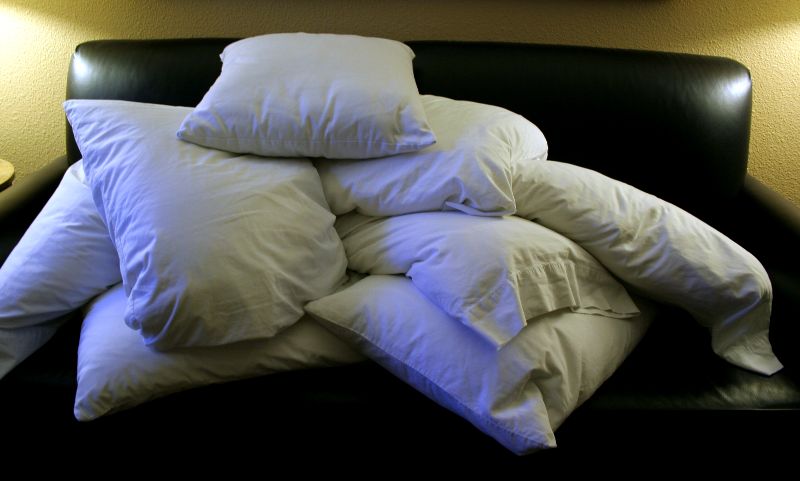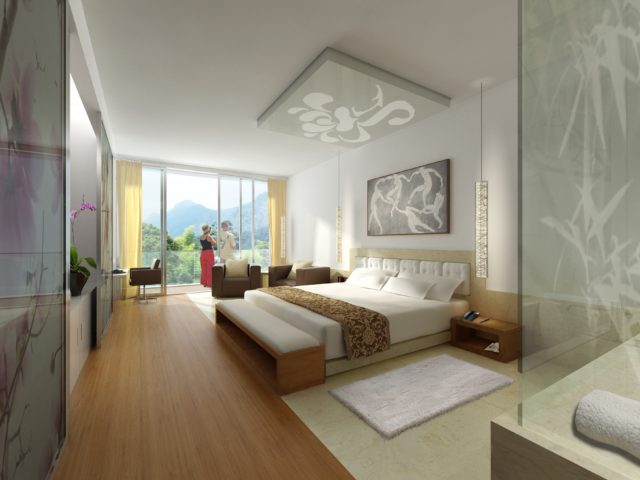A few weeks ago, my stir-crazy overwhelmed my dislike of travel, and I bought plane tickets to North Dakota. At my parents’ place, I reasoned, there would be plenty of space for social distancing and long walks. And staring at somebody else’s walls seemed preferable to staring at my own.
And while I was, in many ways, proven correct, I also remembered that in the normal world, houses aren’t designed for people who can’t sit. The dressers and tables are too low, the chairs don’t have enough padding to kneel on, and the living room has a love seat instead of a couch. What’s a girl to do?
I turned to the Sitting Disability Facebook Group, and asked what other people did to make temporary living spaces sitting disability-friendly. I wish I asked this before traveling, but hey. You live, you learn.
1. Check Before You Go
The best time to start preparing a new place is before you go. Don’t be afraid to message an Airbnb host, or call the hotel to make sure they have suitable furniture.
Jamie T. said, “I make sure I see photographs of the couches to assure me that they aren’t all loveseats. If I’ll be monopolizing the couch, I make sure my travel partner has somewhere to sit! If the photos are unclear, then I write the Airbnb host and get information about couch number and couch length.”
I once stayed for three weeks in an Airbnb where the only couch was about a foot too short for me to lie down on. An email to clear this up would have been 100% worth my time.
2. BYOP (Bring Your Own Pillows)
Once, I asked my roommate if she and her husband had any pillows I could throw in the washing machine to make a load. “We only have one pillow,” she said, and she wasn’t kidding.
I, on the other hand, have approximately 146 pillows, and I need them all. They are perfect little devices to lie on, place under my back, prop up my head, or, when it is unavoidable, to sit on. I don’t know why I never thought to travel with my own pillow.
Many people with sitting disabilities make a point of bringing their preferred style of pillow with them. Depending on individual needs, that could be a donut cushion, foam pillow, inflatable pillow, or just a whole stack of regular bed pillows. It sure beats wadded-up sweatshirts and blankets.
Denise A. combines her cushion with an ice pack for maximum comfort. “For sitting, I use a donut cushion placed inside a discrete bag with handles. Then I take a moldable frozen ice pack, wrap it in three dish towels, and put it in the donut hole.”

Photo courtesy of Danpape via Wikimedia Commons.
3. Make Your Own Standing Desk
In the regular world, standing desks are not as common as one might hope. But a resourceful person can make their own.
Julie G. said, “Sometimes I’ll put a bedside set of drawers, or small coffee table, on top of another table. Or I’ll stack some books on a higher table so that I can stand.”
Meanwhile, Jamie T. found a multi-purpose solution. “I have a cardboard box at the absolute perfect height to put on top of a 30-inch table. If I pack it with supplies for the trip then I have both!”
I’ve been stuck in hotel rooms where I’ve fashioned standing desks out of ironing boards and dressers. Once, at a sketchy bed and breakfast in Glasgow, I stacked my suitcases and pillows on top of the bed. It wouldn’t be my first choice, but it worked.
If you know you’re going to be spending a lot of time at your desk, don’t leave the matter to chance. Francesca P. says, “I’m planning to work away from home for a period and I will have to rent a van to transport my standing desk.”
4. Lawn Chairs to the Rescue
If a zero-gravity chair takes the pressure off, you’re in luck. Folding zero-gravity chairs are inexpensive and widely available. Plus, they travel well, so why not bring your own?
If you need to lie flat, then portable mats might be a better option. Lyndal T. uses a yoga mat on the floor, while Jamie T. uses a thick, inflatable camping pad.
5. Find an Ice Maker
Linda V. relies on ice packs to help control her sitting pain. But unlike cushions or folding chairs, ice needs to be replaced regularly. Her gold standard when searching for lodging is an ice maker in the fridge. A freezer (or freezer compartment) is non-negotiable.
“Hotels generally won’t let you store ice packs in their downstairs freezer because of concerns about health or proximity to food,” Linda said. “We can’t stay in a place unless the room has a freezer.”
6. Factor in Food
You are probably planning to do more at your new location than sleep and work. You will presumably need to eat, and you will not want to sit down to do it.
When planning a trip, Jeff T. researches restaurant options, in addition to lodging. “If I’m staying at a hotel, I always make sure there’s room service, or a nearby restaurant with delivery. And I’ll search Google for pictures of nearby restaurants that have high bistro chairs and tables if I want to get out for a quick bite.”
I once lucked out and found an Airbnb that had a high table in the dining area. Another time, I stayed at a place that had a bar attached to the kitchen island.
Those were ideal cases; at other times, I’ve had to fashion a place for myself at a windowsill, or on the kitchen counter with the aid of a box. Both worked well enough when I was alone, but it doesn’t exactly facilitate conversation when you’re stuck staring at a wall.
Travel may still be a tricky and uncomfortable challenge, but why make it worse than it has to be? Hopefully, with these tips, you can find some comfort at your final destination.
Now, if only they could start installing treadmill desks at Airbnbs.
